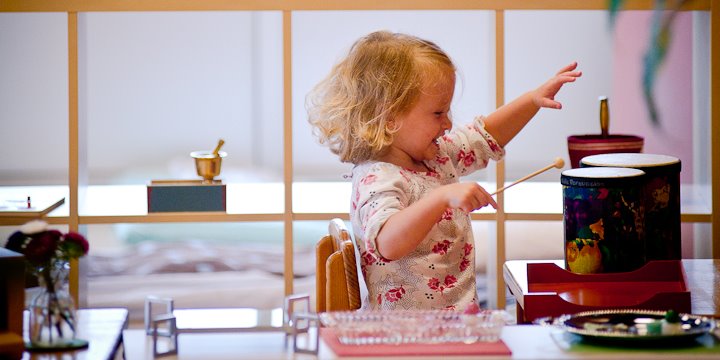
October 27, 2022
As a mother of a child approaching preschool, I’ve noticed the conversation about how to choose a preschool and what type to go with popping up more and more around me. Parents debate the merits of academic vs free-play schools, Montessori vs Waldorf, etc. I’m happy to offer up my advice and insights on the benefits of Montessori, and also am curious to hear what others’ experiences are. Recently I’ve noticed several people criticize Montessori as not allowing the children to “play” enough, of being too structured rather than letting them fully explore their creativity and imagination.
At first, I’m taken aback by this perception of Montessori schools. Montessori gives children such great opportunities to be creative! But then I thought about it some more, and I think I see the problem– children in a Montessori school don’t “play” the way we’re used to seeing children play. Children tend to play pretend, make-believe stories, etc. It is true, a Montessori classroom will have very little of that. And as more and more studies come out confirming the importance of free play in childhood and in children’s development and learning, I can see parents being “turned off” from Montessori because of this.
But, the thing is– while one may not see “play” in a Montessori classroom, the spirit of play is very much still there.
What is it that children are doing when they play? They are practicing. They are experimenting. They are discovering. A child playing with a toy will turn it this way and that, make it go here and there, do the same action over and over, then try something completely different just to see what will happen.
Now imagine a young child working with the pink tower. What does this child do? She practices stacking the tower as her teacher has shown her. She experiments with different configurations for the cubes. What happens if she places the smallest cube on the bottom, then the largest on top? What about making two towers? What will they look like if she lines them up horizontally on the rug, instead? She discovers cause and effect, relationships in dimension, and lessons in gravity.
(As an aside, when I was going through my training we had to spend several hours a week working with the materials, just as the children do, to become fully familiar with them. One of my favorite materials to work with was the constructive triangles. It seemed no matter how long I worked with them, or how many times I thought I had exhausted every possible combination and shape I could make with them, there was always something new I would then discover that I hadn’t thought of before.)
One comment I heard recently was about how you won’t see dolls or play kitchens in a Montessori classroom (as proof that pure play does not exist there). I think this is another very interesting distinction. Children often play pretend because they want to be part of our adult world, but can’t be. They want to cook in the kitchen, sweep the floors, and wash and fold clothes as we do. But for most children, those opportunities are not there (what if they hurt themselves? What if they mess up the laundry I just spent half an hour folding?), so instead, we buy them toys to mimic these activities.
In Montessori, instead of mimicking adult activities, we give the children the chance to actually do them. Many Montessori schools (budget-allowing) have child-sized kitchens where the children will actually cook and bake meals and treats for their classmates. Children have the chance to plant and tend to their own gardens, hand wash towels, and cloth used in the classroom, set the tables up for lunch, etc. There’s no need to pretend when you can actually do the real thing.
So yes, it’s true, you won’t see play kitchens in a Montessori classroom, nor will you see children playing pirates or princesses. Instead, you will see children who are engaging in the very activities most children only get to “pretend” to do and using their creativity and imagination to explore the materials in ways that often surprise even the most experienced teachers.